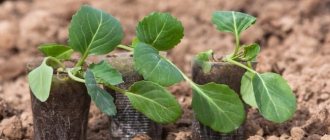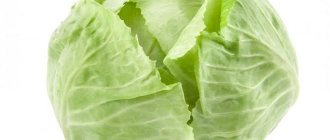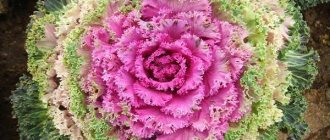What kind is this?
Cabbage (lat. Brassica olerácea) is a plant from the Cruciferous family. White cabbage is one of the varieties.
- In the first year of growth, it forms thick greenish leaves that fit tightly to each other, forming a head of cabbage.
- In the second year , a long stem grows from it, yellow or white flowers form, and dark brown seeds ripen in pods.
Useful properties and taste
Juicy, crispy, sweetish vegetable . Suitable for complete dietary nutrition and weight loss.
- Low in calories.
- Contains tartronic acid, which inhibits the conversion of carbohydrates to fats.
- Pectin and fiber help the gastrointestinal tract and cholesterol removal.
- Rich in minerals and vitamins.
How to grow cabbage
Every gardener can find white cabbage. This is one of the most common crops in gardens. This is a cold-resistant plant that loves light and moisture. Before receiving seeds, cabbage grows for two years. During the first year, the head of cabbage grows and forms, and in the second year, the peduncle.
On average, cabbage grows from 300 g to 15 kg, depending on the variety and growing conditions. This is a fairly resistant crop to different conditions. She feels good even at temperatures below +15 degrees.
However, young seedlings are sensitive to climate changes and low temperatures in spring.
Cabbage can withstand frosts down to -5 degrees, and adult plants can tolerate frosts even at -8 degrees.
High temperature negatively affects the development of the vegetable. When increased to +30 and above, the development of the plant stops. If the heads of cabbage have not begun to set, then they will no longer form.
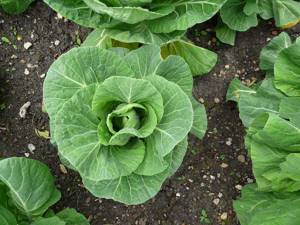
An important feature of the growth of white cabbage is its light-loving nature.
Even in slight shade for several hours a day, seedlings stop growing and wither.
It also requires careful care and periodic removal of weeds. You cannot plant cabbage next to fruit trees. Radishes, dill and lettuce will be good neighbors in an open-ground garden. These vegetables have time to grow even in the initial stages of cabbage growth. Cabbage has a beneficial effect on tomatoes and potatoes; these plants are less susceptible to late blight.
Planting cabbage seedlings
To speed up the timing of the ovary of a head of cabbage, cabbage is planted as seedlings, especially in those regions where the summer is not characterized by warm temperatures and good weather. But it’s worth noting right away that this is a rather complicated method.
Cassettes, boxes or containers are suitable for growing cabbage seedlings.
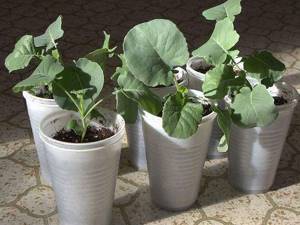
When growing at home, monitor the temperature. Cabbage germinates and grows at a temperature of +10 degrees. To avoid damaging the root system, replant the plants together with a lump of earth.
You can buy soil at the store, or you can make it yourself. It should contain a lot of fertile substances and have a slightly acidic reaction. To do this, mix turf soil with humus, peat and ash. In addition, thoroughly loosen the soil for planting.
Make grooves and carefully pour in the seeds. If possible, leave space between them so that later you have to pick the seedlings less. The soil should be well moistened. Cover the plantings with film or glass and put them in a dark, cool place until shoots emerge. After the first shoots appear, the cabbage seedlings move to a bright place. If there is not enough light yet, then use a phytolamp to prevent the seedlings from stretching.
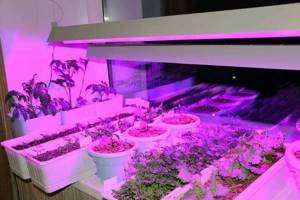
The plant is very demanding on soil, care and light. It is very important to keep the soil moist. But do not water the cabbage with cold water. Warm the water to room temperature. Also, be sure to settle it so as not to water the cabbage with chlorinated or high-iron water. Such water becomes a source of spread of diseases. Plus, the roots do not absorb such water well. It only creates the appearance of watering, but in fact, the plant becomes dehydrated and slows down in growth.
It is best, when growing seedlings, to plant cabbage in peat cassettes, since it does not have to be picked, and the roots will remain intact when transplanted into open ground.
When to plant cabbage and according to what planting pattern
Sow seeds depending on the weather conditions of the region:
- early ripening varieties of cabbage - in early March;
- mid-season - from late March to early April;
- late-ripening varieties - in April.
More precisely, the timing of sowing seeds can be calculated based on the following data: seeds germinate 10 days after sowing, and seedlings are transplanted into open ground after 50-55 days. Accordingly, depending on when the weather usually becomes stable and the threat of frost passes, calculate the planting time 60-65 days in advance.
When planting seedlings or seedlings, do not thicken them. Plant plants at a distance of 50-70 cm from each other and row spacing of 30-40 cm.

Growing rules
If the right conditions have been created for growing cabbage, it will set quite quickly. When the first true leaves appear, they begin to form a head. If this does not happen, then look for the reason. There may be a lack of nutrients, watering or light. In the latter case, it is better to transplant the cabbage to a new place where there will be light shade and enough light. It should be well lit, but not in direct sunlight.
To make the plant feel good in a new place, replant it together with a lump of earth without damaging the roots. To do this, dig in lightly with a shovel and pull the leaves straight up.
When the seedlings have begun to grow and become stronger, carry out regular hilling. You can rake cabbage only after the plant has rooted. This is an important stage in growing a crop, due to which the supply of oxygen to the roots is improved and moisture is retained in the soil. This means the plant is actively growing and setting forks. To make the harvest more abundant and of higher quality, there are several gardening techniques for growing cabbage:
- Growing white cabbage in straw
. Place the straw in beds and water for 3-5 days. During this time it will become saturated and swell. Next, mineral fertilizers are added to the soaked straw: potassium and ammonium nitrate, superphosphates, magnesium and iron sulfates. Thanks to this, decomposition processes begin, which increase the temperature to +50 degrees. In a couple of weeks it will drop to +25-30. Then fill the bed with soil and plant the seedlings.
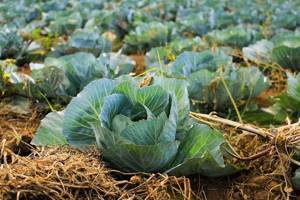
- Early cabbage is sometimes planted under film
so that accidental frosts or a drop in temperature at night do not disrupt its growth and development. Remove the film when the weather becomes stable and the seedlings have taken root and become stronger.
As for seed material, you can buy seeds in a store or grow them yourself in the second year of plant growth. Leave a couple of heads of cabbage for growth next year. A peduncle will appear, and at the end of summer seeds will appear on it
Why does cabbage crack?
Sometimes gardeners encounter cabbage cracking.
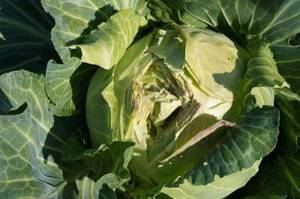
This may happen due to:
- lack or excess of moisture;
- lack of nutrients;
- a sharp increase in watering before harvesting, new leaves form in the head of cabbage, but the volume of the fork is not enough.
To avoid cabbage cracking, experienced gardeners recommend mulching the soil under the cabbages. This will help retain moisture in the soil and ensure its uniform supply at different stages of growth.
The best varieties
They are divided into groups according to ripening time, taste and purpose. Traditional and hybrid varieties are grown.
- Early ones ripen in 50–120 days. The head of cabbage is loose, juicy with a delicate taste, and cannot be stored.
- Mid-season (90–150 days), these are varieties for sourdough, pickling and salads.
- Late species (160–210 days) last all winter; they are fermented or canned. They weigh up to 10 kg.
For regions, zoned varieties of cabbage are recommended.
For Siberia
- Early varieties : Cossack F1, June, Kevin F1.
- Mid-season : Tobia F1, Semko Yubileiny 217 F1, Vyuga and Nadezhda.
- Late : Kolobok F1, Valentina F1, Sibiryachka 60.
For the Ural region
- Early : Transfer F1, Dumas F1, June, Cossack F1.
- Mid-season : Menza F1, Gift, Jubilee F, Slava-1305.
- Late varieties : Amager, Aros F1, Krumont F1.
For the Moscow region
- Early : Resistor, Dumas F1, Zarya.
- Mid-season : Slava 1305, Gift, Pegasus.
- Seeds of late varieties : Valentina F1, Albatross, Zimovka 1474, Amager F1.
Growing white cabbage in seedless culture
The optimal time for sowing cabbage in a non-seedling crop is to warm the top layer of soil at the seeding depth to 8–10 °C (in the middle zone of the republic – the 2nd–3rd decade of April – the 1st decade of May). When sowing with precision seeders, the seed consumption rate is reduced by 20–25% and amounts to 0.25–0.3 kg/ha. The seeding depth is 2–2.5 cm. Seeds with a laboratory germination rate of 92–95% are sowed at intervals of 15–20 cm in a row; with a seed germination rate of 85–90%, the distance in the row is 10–12 cm. If necessary, normalize cabbage plants carried out manually in the phase of 4–5 true leaves. In the future, care for crops should be the same as when growing cabbage from seedlings. With conveyor growing, a marketable harvest of cabbage of early varieties can be obtained by sowing until mid-June, mid-season and mid-late varieties - until May 20.
Features of agricultural technology
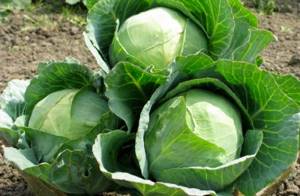
Several features of cultivation technology:
- if the climate is unstable, you will have to cover the plantings in the spring;
- the crop requires regular watering, weeding and several feedings;
- hilling is necessary;
- disease and pest control will be required.
Seedling method
The method is labor-intensive, but reliable, and early products are obtained. Varieties with a long growing season are grown.
What should you do with the seeds?
Before sowing:
- Hardening will increase resistance to fungal diseases. Keep the seeds in water at a temperature of 50°C for 20 minutes, then pour cold water for 5 minutes.
- Soaking in a growth stimulator. Strictly according to the instructions on the package.
- Some seeds cannot be soaked before sowing!
Sow in the middle zone no earlier than mid-February, but no later than mid-April.
Soil preparation
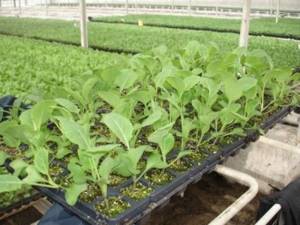
Suitable boxes for sowing are 7 cm high, dairy bags (7x7x7 cm), and peat pots. The prepared containers are treated with a weak solution of copper sulfate.
How to grow seedlings?
Before sowing, the soil is watered, the seeds are buried 1 cm, sprinkled with soil, lightly compacted and covered with glass or polyethylene. For germination, a temperature of at least 20°C is required. Then they are grown with and without subsequent diving.
- In the first case, the sequence of actions is as follows:
- When shoots appear after 5–10 days, the glass or polyethylene is removed, the temperature is reduced to 15–17° during the day and 8–10°C at night. Place the seedlings in a bright place and thin out. Each sprout is left with an area of 2x2 cm.
- After 2 weeks they dive. Pinch off the main root. Plants are buried down to the cotyledon leaves and placed according to a 3x3 cm pattern.
- After 2 weeks, the young cabbage is transplanted for the last time into cups or bags before planting in the ground.
- The second method is less labor-intensive and involves gentle cultivation.
- Seeds are immediately sown in pots or bags 7x7x7 cm, 2-3 in each, then thinned out.
Sprout as in the first method.
- Do not replant until open ground.
Plants are less damaged and roots develop well.
Lighting conditions and watering
Plants need 12-15 hours of light to prevent stretching. Use any lamp. Water regularly with settled water at room temperature. When overwatered, there is a risk of fungal diseases.
Feeding and hardening
Carry out 3 times:
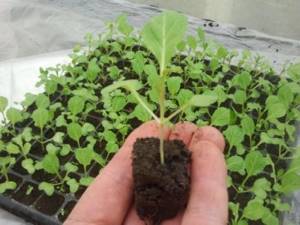
- A week after the dive, after watering the seedlings so as not to burn the roots, add (2 g of potassium fertilizer and ammonium nitrate + 4 g of superphosphate per 1 liter). A liter of solution for 50–60 plants.
- After 2 weeks, feed with the same composition, increasing the amount of fertilizer by 2 times.
- 2–3 days before planting in open ground, prepare a solution: 3 g of ammonium nitrate, 5 g of superphosphate, 8 g of potassium fertilizer per 1 liter of water.
2 weeks before planting, seedlings are hardened:
- For the first 1–2 days, open the window for 3–4 hours.
- Next, they take the boxes out onto the balcony or loggia, leaving them in the sun for 2–3 hours. The first time it is slightly shaded.
- After a week, reduce watering. They don't clean the balcony.
By the time of planting, the seedlings should have 4–5 leaves.
Moving to open ground
Selection and preparation of a site
The bed for the crop is selected and prepared in advance. Organic fertilizers are added to the soil, and acidic soil is limed. In the spring, the chosen place is dug up, cleared of weeds, and loosened. If the soil is heavy, add sand. To increase fertility, humus is added. A flat, open, illuminated place is suitable so that water does not flow down when watering . Away from trees, bushes and buildings that shade the area.
Step-by-step instruction
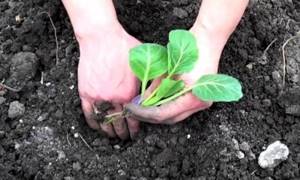
- The seedlings are watered.
- Choose a cloudy day.
- Prepare holes with a diameter of 15–20 cm and a depth of 10–15 cm. Layout: for early cabbage 25x45 cm, for the rest 40x60 cm.
- The depressions are watered with warm water.
- The seedlings are placed in the center, covered with soil up to the first leaf, and the soil around the plant is compacted. The central bud is not covered with soil.
- Mulch the space near the stem with peat or other organic matter.
- Protect plantings from the sun.
Feeding and fertilizing
In order for the seedlings to become strong and grow more intensively, fertilizing is applied to the plants. As soon as the leafy part of the cabbage begins to develop, you should add a solution of ammonium nitrate to the plants (10 g of dry matter per 10 liters of water). This volume of liquid is enough for 5-6 bushes.
Popular: Planting, care and use of exotic okra in the ground
When forming the stalk of cabbage, a complex fertilizer is applied under the plant, which includes potassium sulfate - 8 grams, urea - 4 grams, superphosphate - 5 grams. All components must be diluted in 10 liters of water.
Early varieties of white cabbage: June
Probably every gardener has at least once tried to grow such a popular cabbage variety as “Iyunskaya” in their garden. It should be noted that this variety is appreciated by our compatriots. This white cabbage grows well in temperate climates.
This vegetable crop has excellent taste. The structure of the head of cabbage is very dense, the leafy part is juicy and tender. The cabbage tastes pleasant and slightly sweet. When preparing snack salads, the taste of this variety of cabbage goes well with other types of vegetables.
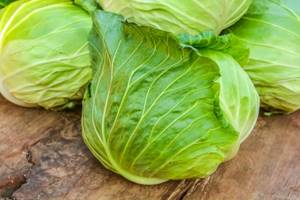
The head of “June” cabbage weighs on average 2-3 kg, which is why it is used sparingly for preparing necessary dishes. From the name of the variety it is already clear that the head of cabbage is ready for consumption at the end of the first summer month. You can grow June cabbage both in greenhouses and in open ground.
Nomozi "R. ABOUT."
This vegetable crop is one of the earliest ripening varieties. After the seedlings have been planted in the ground and until a full stalk is obtained, it often takes an average of 43-45 days. The variety belongs to the hybrid mesh and has good yield.
The head of this type of cabbage is smooth and looks like a round ball. On average, one fork can weigh up to 2 kg. The head has a dense structure and is practically resistant to cracking. Can be stored for a long time and tolerates transportation well.
Many gardeners like this variety because it is persistent. For example, even in seedlings, this cabbage tolerates the low temperature of return frosts. It practically does not suffer from “black leg” and is not susceptible to rotting or fungal infection.
Varieties of late white cabbage.
Amager 611
This variety of cabbage is one of the “long-livers”. For many decades, the vegetable of Soviet selection has occupied one of the places of honor when grown on personal plots and farms. Back in 1943, mid-late cabbage was included in the State Register.
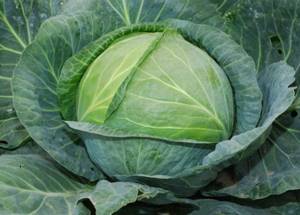
This cabbage can thrive in many climate zones. The growing season usually lasts 118-140 days, but here everything will depend on weather conditions. Amager 611 cabbage has a fairly powerful rosette; its diameter can be up to 70-80 cm.
The deciduous part of this variety is interesting: sometimes it can be round in shape, and in other cases it grows, bending slightly upward. From the outside, the leaf resembles a musical instrument - a lyre. The leaf surface is smooth, but with some wrinkles. Most often, the leaves have a bluish coating.
Popular: Affordable methods for winter and spring planting carrots
When created under optimal conditions, it can be stored until May. True, from time to time the cabbage should be sorted, discarding spoiled leaves or heads of cabbage. But the most important advantage of the Amager 611 cabbage variety is its good immunity to putrefactive bacteria.
Moscow late
This late-ripening cabbage variety has a couple of varieties with different markings - these are “9” and “15”. The vegetable crop was first bred in the last century in the 40s. Both varieties are similar to each other, the only difference is the external parameters, they have different sockets.
Cabbage "Moscow late - 15" has a tall stem. In principle, this is even convenient for the gardener, since the hoe can freely pass under the plant during weeding, loosening or hilling.
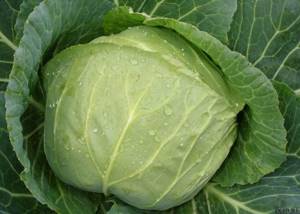
But the cabbage variety “Moscow Late-9” is low in height and squat. From the outside, sometimes it may seem that the vegetable is simply lying on the earth's surface. Although weeding such a plant is a bit difficult, it has its own positive quality - it is not affected by clubroot.
Sowing in open ground
The advantage is strong shoots that do not “get sick” after transplantation. The requirements for soil and space in the garden are the same as for the seedling method.
How to grow vegetables in the country:
- Sow in mid-April to a depth of 2.5–3 cm, when the soil is moist.
- The seeds are disinfected. Place in a solution of potassium permanganate (5 g per 0.5 l of water) for 20 minutes and wash.
- The average seeding rate is 1.2–2 g per 1 m2.
- The emerging shoots are watered.
- Thin out at a height of 15 cm, leaving the strong ones.
Growing seedlings
It is advisable to plant white cabbage seedlings in the middle zone of our country, as well as in Siberia and the Urals . The seedling method reduces the time of cultivation in open ground and allows you to obtain the earliest and highest yield of garden crops.
To reduce the risk of damage to the root system as a result of picking, it is recommended to grow seedlings in individual seedling containers. A mixture based on peat, matured humus or compost, with the addition of rotted sawdust, turf soil and coarse sand, has proven itself well as a soil substrate for growing seedlings. It is not recommended to add mineral fertilizers when sowing seeds for seedlings.
Care and cultivation technology
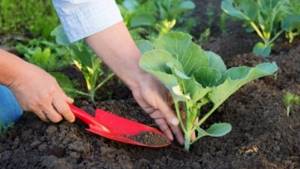
- Feeding:
- 2-3 weeks after transplantation per 1 m2 - 5 g of urea, 10 g of superphosphate, 8 g of potassium salt;
- a month later with the same composition;
- at the beginning of the formation of heads of cabbage per 1 m2 - 12 g of urea, 8 g of potassium salt.
- Loosening the soil, weeding.
- Hilling 3-4 times per season.
- Regular watering, stop 2 weeks before harvesting.
Selection and planting of white cabbage seedlings
After sampling from greenhouses and open ground, the root system of seedlings is dipped into a solution with a creamy creamy consistency: clay with the addition of one of the insecticides - Decis, k.e. – 4–6 ml, Prestige KS – 0.05 l (per 10 l of solution). Against bacteriosis, add Mykolin, w – 1.0 l/10 l of water or Phytoprotectin, TPS (0.04 per 10 l of “chatter”). The prepared seedlings are loosely placed in boxes and transported to the planting site. Seedlings are planted on the day of sampling, but no later than 1–2 days after it, provided they are stored in refrigerated storage. Cabbage seedlings are planted using SKN-6, SKN-6A or MP-6 transplanting machines by cutting slits with coulters while simultaneously supplying water to them, planting the seedlings and squeezing them with soil using pressing wheels and rollers. When planting seedlings, watering is required. Water consumption – 0.5 l/plant. After planting, for better rooting of seedlings, do not water for 2–3 weeks. Optimal planting density of seedlings, thousand pcs/ha: early varieties and hybrids – 55–60 (70 × 24–26 cm); mid-early – 45–50 (70 × 28–32 cm); medium-late – 35–40 (70 × 35–40 cm) and late for long-term storage – 30–32 (70 × 45–50 cm).
Diseases and pests
| Name | Disease/pest | What amazes | Ways to fight |
| Blackleg | Fungal diseases | root collar |
|
| Kila | roots | ||
| Cabbage aphid | Pests | leaves |
|
| Cruciferous flea beetle | |||
| Cabbage fly larvae | roots | Repel insects with plants with a strong odor, tobacco dust or mothballs. | |
| Cabbage butterfly caterpillars |
Sowing white cabbage seeds
Absolutely all varieties of white cabbage are propagated by seeds. Before sowing, seeds should be pre-treated and prepared. Pre-sowing seed preparation involves several sequential activities:
- seeds collected independently or purchased from hand must be sorted by size and appearance;
- to protect garden crops from fungal diseases, the seed material should be kept for a quarter of an hour in water at a temperature of 48-50 ° C, and then immersed in cold water for a couple of minutes;
- good results are obtained by treating seed material with Fitosporin-M or a mixture based on Alirin-B and Gamaira for 12 hours at room temperature;
- After processing, garden seeds need to be dried to a free-flowing state.
Starting in May, cabbage seed can be sown on pre-prepared beds in open ground. It should be remembered that direct sowing in open ground is used for growing early varieties of white cabbage.
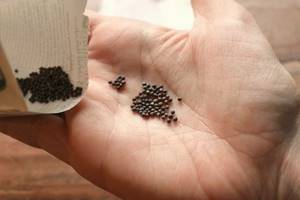
Harvesting
Salad cabbage ripens in mid-summer and is cut when ready. Late - at the end of September. Cabbage is not afraid of light frosts. The productivity of late ripening ones is 2 times higher than that of early ripening ones. Even in Siberia, late varieties yield 5–6 kg per 1 m2.
White cabbage is the most popular type of cabbage . Medicinal and taste qualities compensate for the cost and effort of cultivation. With good care it produces a rich harvest.
We recommend that you familiarize yourself with other, no less tasty and healthy, varieties of cabbage: red cabbage, Savoy, cauliflower, Peking cabbage, broccoli and kohlrabi. Also read about such popular varieties as Aggressor, Megaton, Kale and Pak Choi.
Features of garden culture
Common and familiar to domestic consumers, young white cabbage, raw or heat-treated, not only has an excellent taste, but also has many medicinal properties. The vitamins, minerals and fiber contained in cabbage pulp are used for medicinal purposes, and the balanced composition of the cabbage juice allows cabbage dishes to be used for preventive purposes, as well as in many diets. However, it is important to remember that if you have a chronic disease of the stomach and intestines, you cannot eat cabbage dishes uncontrollably.
June cabbage is especially tasty and healthy, having the most tender and juicy leaves, which are widely used for preparing both first and second courses, as well as salads and cold appetizers. To produce winter preparations, it is recommended to use late cabbage, which is harvested in the autumn.
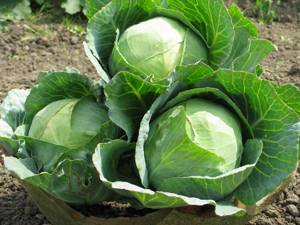
It is recommended to grow white cabbage in areas after harvesting garden crops such as cucumber, garlic, onions, potatoes, carrots, and legumes. It is impossible to allocate beds for cultivation after cultivating radishes, radishes, arugula and other cruciferous vegetables.
Poor, insufficiently fertile soils should be pre-enriched with nutrients by adding approximately three to four buckets of humus or peat per square meter. The soil must have a neutral pH reaction, and in acidic areas, liming with dolomite flour is mandatory.



